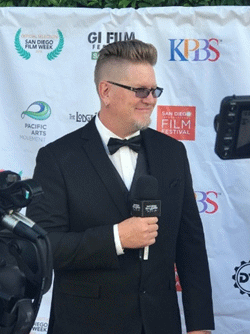PROGRAM

Tell us how you came to make the film?
I made Break of Dawn because I’m drawn to psychological thrillers and horror that explore how people respond to real, grounded terror—especially the kind rooted in emotional pain. For me, the most haunting stories come from within, and in this case, it was the lasting impact of childhood trauma. I wanted to show how unresolved trauma doesn’t just stay with one person—it echoes through a family, shaping relationships, behaviors, and choices, often in destructive ways. The horror in Break of Dawn isn’t just about what’s lurking in the dark, but how that darkness seeps into the fabric of a family and leaves a lasting scar.
All our shorts were judged by their variety of location and big-screen cinematography, tell us a bit about the locations. Were there any special challenges while filming?
The gas station scene was filmed at an old, abandoned station near Lake Crenshaw—about 30 minutes north of Ramona in San Diego County. Since the story is set in 1971, we built a vintage gas pump and added period-accurate signage to match the era. Everything was going smoothly… until the site’s caretaker gave us one condition: his Great Dane had to appear in the film. My first thought? Uh-oh. Animals on set are always a gamble. But this dog? He sat still for the entire three-hour shoot—didn’t move a muscle. Honestly, he was the easiest actor I’ve ever directed.
The house scenes were pieced together from multiple locations to make everything work. The exterior and the wood-chopping scene were filmed at a house in Ramona, about five miles from where we shot Dawn’s reaction through the window. The kitchen and junkyard scenes were also filmed at that same Ramona location. The scene where the characters walk into the field was filmed elsewhere.
The final field shot was actually done over two weekends—one side of the scene the first week, the other side the next. Between changing light, actor availability, and weather, it was a logistical headache. But somehow, the clouds matched almost perfectly across both weekends, so the cuts are seamless. You’d never know the footage was shot a week apart.
The bedroom scenes were done on a soundstage. We needed the space for complex camera moves that wouldn’t have been possible in a real bedroom.
Why did you decide to be a filmmaker??
I fell in love with filmmaking back in 9th grade during a class project where we made a detective noir film. I played the detective, but what really hooked me were all the behind-the-scenes elements—camera work, lighting, directing, editing. That project sparked something in me, and 40 years later, I’m still just as passionate about telling stories through film.
What are some of your favorite genre-shorts (or features) and why?
Some of my favorite films are Seven, Silence of the Lambs, Prisoners, Nightcrawler, Memento, and Zodiac—all psychological thrillers that dive deep into the minds of complex, often flawed characters. What draws me to these films is how they explore the darker corners of human nature. They tap into primal fears and instincts—violence, obsession, justice, guilt—and force us to confront the uncomfortable parts of ourselves. I love how these stories build tension not just through plot, but through character, psychology, and moral ambiguity. They keep you thinking long after the credits roll, which to me, is the mark of great storytelling.
Rich Varville
Producer/Director
619-322-1006